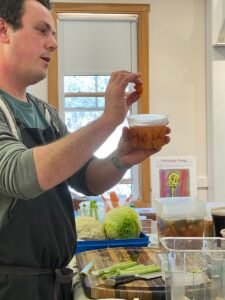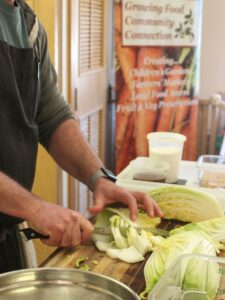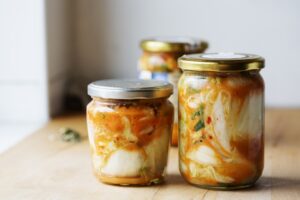Pickles can be polarizing. There are those who favor the fresh crunch of half sours and others who hew to the notion that its sweet edge makes the bread-and-butter pickle the be-all. Not to mention the ways people take sides on the funk of kimchi. If your eyes have already strayed to the recipes here, you know which side I’m on.
But before we go there, let it be known that the practice of pickling is pretty much universal. For upwards of four millennia — the ancient Mesopotamians made pickles, according to the pickle history timeline posted on the New York Food Museum website — people have used acidic brines to extend the lifespans of their foods.
“There are many different definitions of pickle,” says Garrett Smythe, the chef and fermentation connoisseur, kicking off a two-hour course on the subject on March 30 at the Truro Public Library that leaves me primed for kimchi-making.

For the kind of quick pickling Smythe teaches, the process is simple: an acidic brine is poured on pickles-to-be either hot (for cruciferous or otherwise crunchy vegetables like celery, carrots, or cauliflower) or cold (for more delicate produce like peaches or tomatoes). The basic formula, Smythe says, combines vinegar, water, sugar, and salt in a “3-2-1-¼” ratio (that is, 3 parts vinegar to 2 parts water to 1 part sugar to ¼ part salt) — proportions that make for a brine that’s sufficiently acidic to prevent spoilage. (Though it’s important to note that the pickles we’re making and the kimchi do need refrigeration as they aren’t “processed” in a hot water bath to become shelf-stable.)
Smythe starts the class by heating a pickling solution on the stovetop while cutting a head of cauliflower into florets, thinly slicing a red onion, and chopping up celery stalks. He pours the boiled solution over each of those vegetables. He then chops a cabbage and douses it with a pleasingly crimson mixture that includes soy sauce, ginger, and Korean chili powder. Over the course of two weeks, he tells us, this will turn the cabbage into kimchi. We don’t have to wait, though. Like one of those chefs on a television cooking show, he conveniently slides a finished batch out of the library’s fridge for us to try. It’s tart and still a little crunchy, with a complex kick that’s not too hot.
Then he takes it a step further, steaming the kimchi with clams and throwing in a few tablespoons of butter to cut the salinity of the dish. That’s it: kimchi has to become part of my repertoire.

Smythe got his culinary start in the kitchen at Wellfleet’s Wicked Oyster in 2004, and he’ll be back there soon, if all goes to plan, as co-owner with Alex Hay and Sebastien Taffara. A westward move led to years in San Francisco, including a couple in the kitchen of the now-closed Michelin-starred restaurant Michael Mina. Smythe returned to the East, briefly to the Wicked Oyster, and then was the chef at Sunbird in Orleans from 2015 to 2022.
In some ways, Smythe says, the principles at work in pickling are not so different from braising, a long, slow cooking method. In this case, the brine is heated, added to the vegetables, then cooled and allowed to rest, giving the flavors “a chance to marry.”
There’s a reason beyond deliciousness that restaurants include pickled things on their menus: “Acid cuts fat and makes you want to eat more,” Smythe says. An “acidic counterpoint” alongside richer, fattier foods acts as a palate cleanser, he says. That’s why charcuterie boards will have mostardas or cornichons alongside: the vinegar jolt wipes away “palate fatigue.”
When it comes to cold pickling, “If I wouldn’t eat it raw, I don’t cold pickle it,” Smythe says. Now that he’s showed us how easy pickling is, the tips start to roll: all kinds of vinegars can make for a tasty pickle, but don’t use balsamic (its flavor is too concentrated and its acidity generally low); make sure your vegetables are fully submerged in the brine — access to oxygen is what enables bad microbes to develop; never store your pickles in a metal container — its reactivity with acid will give your pickles a metallic bent.
Texture-wise, Smythe says cruciferous vegetables make for perfect pickles. But beware of broccoli, radishes, and cabbage because, once pickled, they can become “quite pungent” and “intense for the uninitiated.” Try pickling dried fruits like golden raisins or cherries; they make for a unique rehydrated garnish and a great addition to chicken curry.
For those looking to learn more about preserving, Smythe recommends Sandor Katz, whose Wild Fermentation came out in 2003, the year before Smythe started his cooking career. The Art of Fermentation followed in 2012. Katz, who describes himself as a “fermentation revivalist,” is “kind of like the godfather of fermentation, at least in this country,” Smythe says. Like Katz, Smythe is an advocate of home cooks losing their fear of pickling. Though he admits that building a pantry full of preserved foods is a commitment.

Smythe delivers his advice with an offhandedness that belies the fact that his larder has been decades in the making. Both of Smythe’s parents were colonels in the U.S. Marine Corps, which led to his intercontinental childhood. He spent four years in Japan and two years in Germany. Studying anthropology at Radford University in Virginia honed his interest in the relationship between food and culture. But based on his upbringing, he says, “I was probably never going to get pinned down to one cuisine.”
That meshes well with the premise of Sustainable CAPE’s Harvest Highlight program that Smythe’s class is part of. It’s about “using global recipes with local food,” says Sustainable CAPE founding director Francie Randolph. Every month, the series highlights a different local harvest. March was about pea shoots.
Smythe pulls a vibrant green pea shoot granita out of the library freezer. To make it, he says, he popped pea shoots and water into a blender and mixed maple syrup and rice wine vinegar into that puree. He shaves some off and plops it on an oyster, which he slurps — to the envious gaze of the 20 pickling mavens in the room. The freezer, he says, is “the overlooked method of preservation that we all have available.” But that’s a class for another day.
BASIC QUICK PICKLING BRINE
Enough for about 4 quarts of pickled vegetables
6 cups vinegar (apple cider, rice wine, red wine; not balsamic)
4 cups water
2 cups sugar
½ cup salt
- Bring vinegar, water, sugar, and salt to a simmer and stir until salt and sugar are dissolved.
- What you do with the brine depends on what you are pickling. If the vegetables or fruits are good eaten raw and are delicate, let the liquid cool before pouring it over them. If the vegetables or fruits can benefit from a quick cooking, pour the boiling liquid over them and let the vegetables and brine cool at room temperature.
- Refrigerate these unprocessed pickles. They will gain flavor but lose crispness over the weeks ahead.
NAPA CABBAGE KIMCHI
Makes about one quart
Note: This recipe calls for a kitchen scale set to grams rather than ounces. Using kosher salt, not iodized, is important because iodine and other anti-caking agents can inhibit fermentation.
900 g. napa cabbage (a small head, under 2 lbs.)
50 g. kosher salt
50 g. sugar
75 g. peeled garlic cloves (about 8-10)
60 g. sliced fresh ginger (no need to peel, just scrub)
270 g. soy sauce (typically gluten free)
60 g. gochugaru (Korean chili flakes)
50 g. maple syrup
- Remove the stem and any poor-quality outer leaves from the cabbage. Roughly chop the rest, rinse well, and drain. Toss with salt and sugar and let sit in a covered container overnight. Drain well before adding to remaining ingredients.
- Combine garlic cloves, ginger slices, soy sauce, gochugaru, and maple syrup in the bowl of a food processor and blend well.
- In a large bowl, pour all of the sauce over the well-drained cabbage and mix thoroughly with your hands until the cabbage is well coated.
- Pack the seasoned cabbage tightly in a clean and sanitized nonreactive container (such as a glass mason jar), leaving about an inch of head space at the top, and close the lid firmly.
- Keep kimchi at cool room temperature (60° to 70° F) for at least a week and up to two, opening the jar every couple of days to make sure the cabbage is submerged in the brine (poke it down if it’s not) and to taste it as it pickles. Refrigerate kimchi — it is good at this point but even better if allowed to develop for another week or two.
